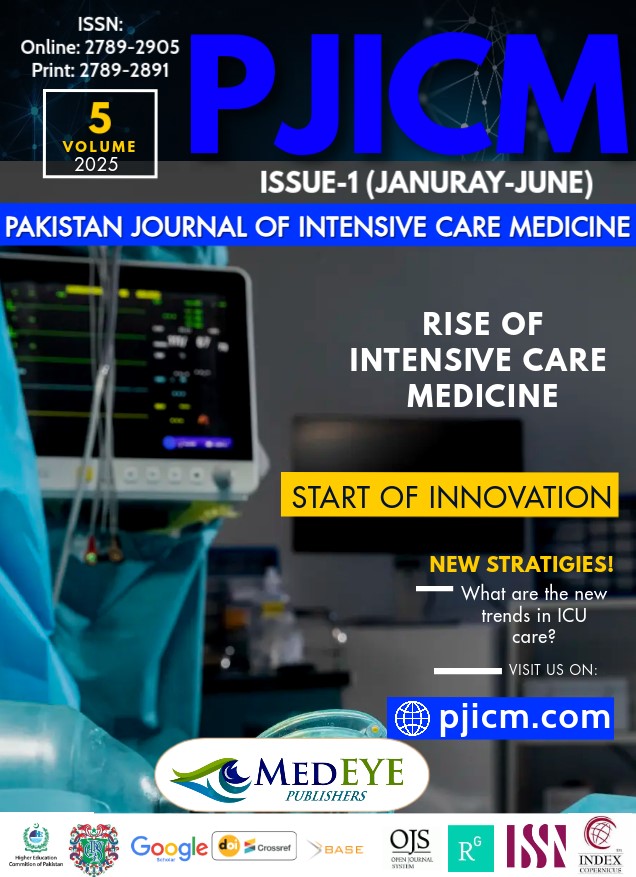INTRACAVERNOUS PLATELET LYSATE INJECTIONS FOR ERECTILE DYSFUNCTION IN DIABETIC MEN: A STUDY ON CLINICAL OUTCOMES AND EFFICACY
DOI:
https://doi.org/10.54112/pjicm.v5i01.55Keywords:
Erectile dysfunction, Platelet lysate, Intracavernous injection, Diabetes mellitus, Regenerative therapy, IIEF-5, PakistanAbstract
Background: Erectile dysfunction (ED) is a prevalent complication among diabetic men, often refractory to conventional pharmacologic therapies due to vascular and neural impairments. Platelet lysate (PL), a growth factor-rich biological derivative, has emerged as a potential regenerative therapy for vasculogenic ED. However, data on its clinical efficacy and safety remain limited, particularly in resource-constrained settings. Objective: To evaluate the efficacy and safety of intracavernous PL injections in diabetic men with moderate to severe ED. Study Design: Prospective interventional study. Setting: The study was conducted at the Institute of Kidney Diseases, Peshawar, Pakistan. Duration of Study: February 18, 2024, to February 18, 2025. Methods: A total of 72 diabetic men aged 40–65 years with moderate to severe ED (International Index of Erectile Function-5 [IIEF-5] score: 5–11) were enrolled. Each participant received three intracavernous injections of autologous PL at two-week intervals. Erectile function was assessed using the IIEF-5 questionnaire at baseline and 12 weeks post-treatment. Adverse events were monitored to evaluate treatment safety. Statistical analysis was performed using SPSS v26, with a p-value of <0.05 considered statistically significant. Results: The mean IIEF-5 score significantly improved from 8.6 ± 1.9 at baseline to 15.3 ± 2.8 at 12 weeks (p < 0.001). Improvements were observed in all erectile function domains, including erection confidence, penetration ability, and overall satisfaction. Clinically significant improvement was noted in 86.8% of patients with moderate ED and 73.5% of those with severe ED. The treatment was well tolerated, with mild, transient adverse effects, including penile pain (12.5%) and local bruising (8.3%). No cases of fibrosis, priapism, or infection were reported. Conclusion: Intracavernous PL injections demonstrated significant efficacy and safety in diabetic men with ED, leading to substantial improvements in erectile function and patient satisfaction. These findings highlight PL therapy as a promising alternative for ED management, particularly in patients unresponsive to conventional treatments and in resource-limited healthcare settings. Further large-scale studies are recommended to validate these results.
References
Basit A, Fawwad A, Siddiqui SA, Baqa K. Current prevalence of type 2 diabetes and prediabetes in Pakistan: Findings from the 2nd National Diabetes Survey of Pakistan (NDSP), 2016–2017. BMJ Open. 2021;11(2):e048176.
Jafar TH, Haque WU, Islam M, et al. Diabetes and associated risk factors in Pakistan: Evidence from national-level surveys. Lancet Reg Health Southeast Asia. 2022;5:100069.
Gandaglia G, Briganti A, Jackson G, et al. A systematic review of the association between erectile dysfunction and cardiovascular disease. Eur Urol. 2019;74(5):767–78.
Burnett AL, Nehra A, Breau RH, et al. Erectile dysfunction: AUA guideline. J Urol. 2021;205(3):630–8.
Rezaee M, Meshkini A, Bahaeddini H, et al. Platelet Lysate versus Platelet-Rich Plasma in the Treatment of Erectile Dysfunction: A Randomized Controlled Trial. Andrology. 2021;9(1):148–55.
Al Demour S, Jafar H, Adwan S, et al. Safety and efficacy of platelet-rich plasma for treatment of erectile dysfunction in human subjects: A pilot study. Andrologia. 2020;52(8):e13620.
Zarei F, Barati A, Ghasemi M, et al. Intracavernous injections of platelet lysate for diabetic erectile dysfunction: A new frontier. Sex Med Rev. 2022;10(3):340–6.
Rehman H, Khan M, Aziz A. Erectile dysfunction in diabetic Pakistani men: prevalence and predictors in a tertiary care setting. J Ayub Med Coll Abbottabad. 2021;33(1):80–5.
Saleem H, Naeem M, Sajid MI. Early onset diabetes and cardiovascular risks in young Pakistani males: Implications for sexual health. Pak J Med Sci. 2020;36(4):723–9.
Ahmed Z, Shahid A, Malik A. Hidden burden: Erectile dysfunction among type 2 diabetic males in Lahore. J Pak Med Assoc. 2020;70(6):1014–8.
Arif A, Khan A, Mustafa S. Barriers to ED treatment in Pakistani men: A qualitative study. Sexual Medicine. 2023;11(1):100493.
Rezaee M, Meshkini A, Bahaeddini H, et al. Platelet Lysate versus Platelet-Rich Plasma in the Treatment of Erectile Dysfunction: A Randomized Controlled Trial. Andrology. 2021;9(1):148–55.
Zarei F, Barati A, Ghasemi M, et al. Intracavernous injections of platelet lysate for diabetic erectile dysfunction: A new frontier. Sex Med Rev. 2022;10(3):340–6.
Al Demour S, Jafar H, Adwan S, et al. Safety and efficacy of platelet-rich plasma for treatment of erectile dysfunction in human subjects: A pilot study. Andrologia. 2020;52(8):e13620.
Burnett AL, Nehra A, Breau RH, et al. Erectile dysfunction: AUA guideline. J Urol. 2021;205(3):630–8.
Zarei F, Mazhari S, Mohammadzadeh M. Long-term safety of platelet-derived therapies in erectile dysfunction: A pilot study. J Sex Med. 2022;19(4):652–9.
Arif A, Khan A, Mustafa S. Barriers to ED treatment in Pakistani men: A qualitative study. Sexual Medicine. 2023;11(1):100493.
Ahmed Z, Shahid A, Malik A. Hidden burden: Erectile dysfunction among type 2 diabetic males in Lahore. J Pak Med Assoc. 2020;70(6):1014–8.
Downloads
Published
How to Cite
Issue
Section
License
Copyright (c) 2025 Z MAJEED , M KHAN , MU RAHMAN , N KHAN

This work is licensed under a Creative Commons Attribution-NonCommercial 4.0 International License.












